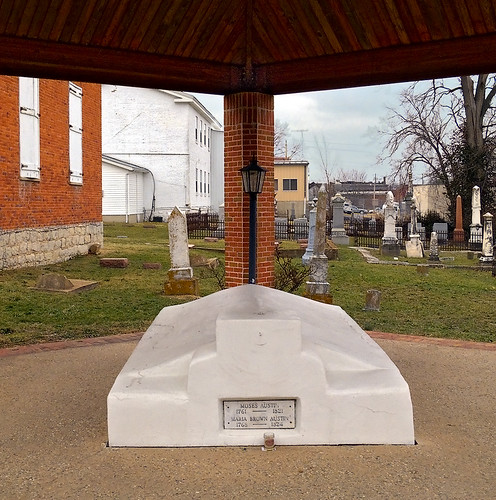
This is the tomb of Moses Austin (1761-1821) and his wife Maria Brown Austin (1768-1824), in Potosi, Missouri. He was born in Durham, Connecticut, and his wife's family had mining interests. Hired to cover the roof of the Virginia capitol with lead sheeting, he was however unable to procure enough of that metal. According to one history:
At this time reports came of rich lead mines in upper Louisiana (now in Missouri), which attracted the attention of Moses Austin. The territory then being under the dominion of Spain, he procured a passport from the Spanish minister to the United States in 1797 and visited that region, and secured from the governor, Baron de Carondelet, a grant of a league of land covering the site where the town of Potosi, Washington County, Missouri, now is, and in [1799] removed there with his family and formed the first American settlement in that section.Austin took Spanish citizenship and is credited for commercializing the lead industry in Missouri, which is now the world's largest. He founded the town of Potosi (named after a Bolivian city known for its silver mines), and Herculaneum, in Jefferson County on the banks of the Mississippi River, and there established a lead smelter. His grand home in Potosi was named Durham Hall, after his birthplace.
He prospered in mining and other pursuits for some years, dispensed a liberal hospitality, and enjoyed an enviable character. But again disaster came. The failure of the Bank of St. Louis swept away his accumulations and left him almost destitute of means, having freely surrendered everything to his creditors. He was now fifty-three years old and began to look around for a new field of enterprise. His residence of twenty years in Missouri had made him familiar to some extent with Spanish laws and methods of administration, and he had also acquired considerable knowledge of Texas through the reports of Captain Pike and others, who, in 1812 and 1813, served under Magee and Perry, and from trappers and Indian traders. In possession of such knowledge and animated by an enterprising spirit, his mind naturally turned to Texas as a field in which to build up his shattered fortunes. With a forethought justified by results, he conceived the idea of founding a colony of his countrymen in the trackless wilderness of Texas. Traveling by land on horseback, he made the long and perilous trip to San Antonio, Texas, where he arrived on the 23rd day of December 1820. Here, however, as soon as his presence and mission were known, Governor Antonio Martinez ordered him to quit the country, as he had violated its laws by entering the Province of Texas without permission of the Spanish King. This was a sad blow to the exalted ideas of Austin in regard to his colonization of the rich lands of Texas east of San Antonio, and he wearily and in much despondency commenced making his preparations to re-turn home, when, fortunately, he met with the Baron de Bastrop, whom he had known in New Orleans and who was now a member of the municipal government. To him Austin explained the peaceful object of, his mission, and the Baron warmly espoused his cause and commended him to Governor Martinez as a worthy man and a former subject of Spain, and secured for him not only the good will but the earnest cooperation of the Governor and other authorities of the place, and these in turn recommended his proposed application to settle 300 families in Texas to the favorable consideration of General Don Joaquin Arredondo, Commanding General of the Eastern Internal Provinces, with headquarters at Monterey, Mexico.
Moses is now better known for founding the American colony in Texas, completed by his son Stephen, which led to the independence of the Republic of Texas.
The purpose of the heavy concrete slab over his grave is, I kid you not, to prevent Texans from stealing his body.


No comments:
Post a Comment